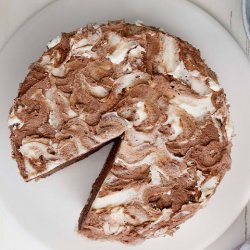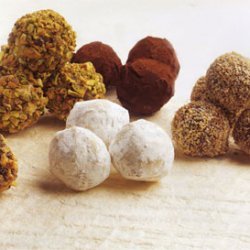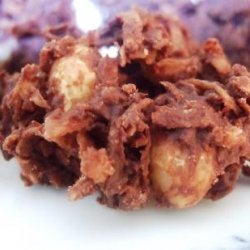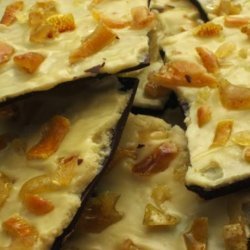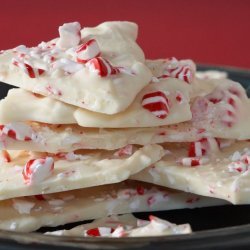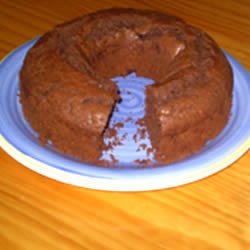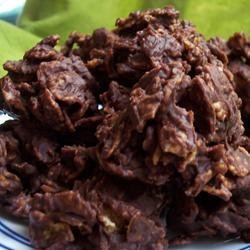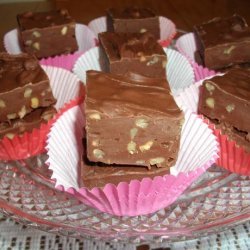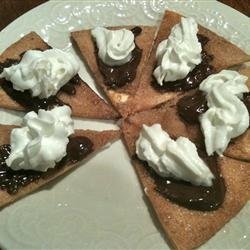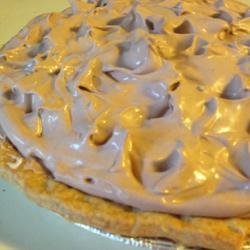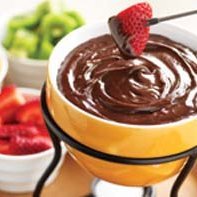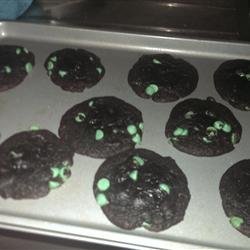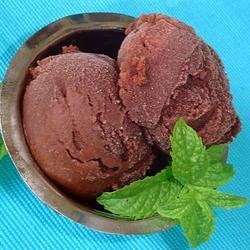Ingredients:
- special equipment: two dish mats, absolutely clean and free of dirt or grease
- special equipment: any plastic or metal object you'd like to mold, such as a soap holder, a slotted spatula, a potato masher, dish mat with holes, absolutely clean and free of dirt or grease
Directions:
- For the Support Stand: Using an offset spatula, spread a 1/4-inch-thick layer of bittersweet chocolate over the textured side of a dish mat, being sure to spread it all the way to the edges. Roll the mat into a tube and let the chocolate set. When it has set, carefully peel the mat away from the chocolate. Using a sharp, hot chef's knife, trim the edges so they are even. Set aside
- For the Base: You will need to two bases for the centerpiece. Place an acetate or parchment sheet on your work surface with the long side facing you. Using an offset spatula, spread about a 1/4-inch-thick layer of white chocolate onto the acetate sheet. Wait until the chocolate sets. Place another dish mat on top of the white chocolate. Using an offset spatula, spread a layer of bittersweet chocolate over the mat. Allow the chocolate to set. Carefully peel the mat away from the chocolate, creating a white base with dark dots. Repeat to make another base. Use a sharp chef's knife to cut a circle from one of the bases, 2 inches larger than the diameter of whatever you will be placing on the pedestal.
- Set the large base on a flat tray. Use a generous amount of chocolate to glue the circular base to one end of the support stand tube. Use more chocolate to glue the other end of the support stand tube to the other, larger base. Be sure the chocolate has set completely and the stand is sturdy before you set anything on top of it.
- If you would like to use a potato masher or a slotted spatula, first place an acetate or parchment sheet on the work surface, then place the utensil on top of the paper. Using an offset spatula, spread a layer of white chocolate over the utensil (filling the holes) and onto the acetate sheet. Carefully, lift off the utensil. Allow the chocolate to set then use an offset spatula to carefully spread a layer of dark chocolate over the white chocolate texture. Allow the chocolate to set. Use a sharp knife or cutter to cut the chocolate into interesting shapes.
- Use these same techniques for any other textured mat and create more interesting pieces for the centerpiece.
- To assemble the centerpiece, use the chocolate to glue the various shapes into place. Use your eye as a guide to create an interesting design. A nice thing to do is to place a cake on the stand and distribute petit fours around the base of the centerpiece. You can also decorate with fresh fruit to add color.
- How to Temper Chocolate (From Dessert Circus, Extraordinary Desserts You Can Make At Home by Jacques Torres):
- Chocolate is tempered so that after it has been melted, it retains its gloss and hardens again without becoming chalky and white (that happens when the molecules of fat separate and form on top of the chocolate). There are a variety of ways to temper.
- One of the easiest ways to temper chocolate is to chop it into small pieces and then place it in the microwave for 30 seconds at a time on high power until most of the chocolate is melted. Be very careful not to overheat it. (The temperature of dark chocolate should be between 88 and 90 degrees F, slightly warmer than your bottom lip. It will retain its shape even when mostly melted. White and milk chocolates melt at a temperature approximately 2 degrees F less because of the amount of lactose they contain.) Any remaining lumps will melt in the chocolate's residual heat. Use an immersion blender or whisk to break up the lumps. Usually, chocolate begins to set, or crystallize, along the side of the bowl. As it sets, mix those crystals into the melted chocolate to temper it. A glass bowl retains heat well and keeps the chocolate tempered longer.
- Another way to temper chocolate is called seeding. In this method, add small pieces of unmelted chocolate to melted chocolate. The amount of unmelted chocolate to be added depends on the temperature of the melted chocolate, but is usually 1/4 of the total amount. It is easiest to use an immersion blender for this, or a whisk.
- The classic way to temper chocolate is called tabliering. Two thirds of the melted chocolate is poured onto a marble or another cold work surface. The chocolate is spread out and worked with a spatula until its temperature is approximately 81 degrees F. At this stage, it is thick and begins to set. This tempered chocolate is then added to the remaining non-tempered chocolate and mixed thoroughly until the mass has a completely uniform temperature. If the temperature is still too high, part of the chocolate is worked further on the cold surface until the correct temperature is reached. This is a lot of work, requires a lot of room, and makes a big mess.
- A simple method of checking tempering, is to apply a small quantity of chocolate to a piece of paper or to the point of a knife. If the chocolate has been correctly tempered, it will harden evenly and show a good gloss within a few minutes.
Nutrition Facts
| Amount Per 1 Serving | |||
| Calories | 7810.99 Kcal (32703 kJ) | ||
| Calories from fat | 3674.16 Kcal | ||
| % Daily Value* | |||
| Total Fat | 408.24g | 628% | |
|---|---|---|---|
| Cholesterol | 344.74mg | 115% | |
| Sodium | 1433.38mg | 60% | |
| Potassium | 2594.59mg | 55% | |
| Total Carbs | 1043.28g | 348% | |
| Sugars | 934.42g | 3738% | |
| Dietary Fiber | 18.14g | 73% | |
| Protein | 81.65g | 163% | |
| Vitamin C | 9.1mg | 15% | |
| Iron | 9.1mg | 50% | |
| Calcium | 2422.2mg | 242% | |
| Amount Per 100 g | |||
| Calories | 430.5 Kcal (1802 kJ) | ||
| Calories from fat | 202.5 Kcal | ||
| % Daily Value* | |||
| Total Fat | 22.5g | 628% | |
|---|---|---|---|
| Cholesterol | 19mg | 115% | |
| Sodium | 79mg | 60% | |
| Potassium | 143mg | 55% | |
| Total Carbs | 57.5g | 348% | |
| Sugars | 51.5g | 3738% | |
| Dietary Fiber | 1g | 73% | |
| Protein | 4.5g | 163% | |
| Vitamin C | 0.5mg | 15% | |
| Iron | 0.5mg | 50% | |
| Calcium | 133.5mg | 242% | |
* Percent Daily Values are based on a 2000 calorie diet. Your daily values may be higher or lower depending on your calorie needs.
Find out how many calories should you eat.
Get Your Recipe of Health!
Follow RecipeOfHealth on Facebook!


